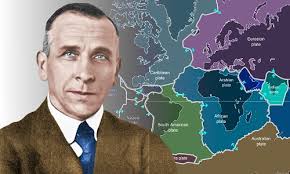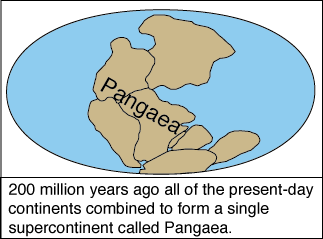The surface of the Earth is broken into large pieces that are slowly shifting. This gradual process is called "Plate Tectonics." Alfred Wegener, a German Scientist, proposed the theory of Continental Drift - The idea that Earth's continents move. Looking at a globe or world map of Earth today, you will notice that the continents fit together like puzzle pieces. Looking at a world map of 1912, Alfred Wegener (1880-1930) noticed the same thing and proposed that the continents were once compressed into a single protocontinent which he called Pangea (meaning "all lands"), and over time they have drifted apart into their current resting places. In his theory, he also believes that "pangea" was still intact until about 300 million years ago. We know this period as the Carboniferous period. The only problem is that his theory lacked geological evidence to explain how the continents could drift apart.
Before I get deeper into Mr. Wegener's theory, lets talk about plate tectonics to help get a better unerstanding of whats going on. From the deepest ocean trench to the tallest mountain, plate tectonics explains the features and movement of Earth's surface in the present and the past. Plate tectonics is the theory that Earth's outer shell is divided into several plates that glide over the mantle, the rocky inner layer above the core. The plates act like a hard and rigid shell compared to Earth's mantle. This strong outer layer is called the lithosphere, which is 100 km (60 miles) thick, according to Encyclopedia Britannica. The lithosphere includes the crust and outer part of the mantle. Below the lithosphere is the asthenosphere, which is malleable or partially malleable, allowing the lithosphere to move around. How it moves around is an evolving idea.
Mr. Wegener believed that Pangea originated near the south pole and that the centrifugal force of the planet caused the protocontinent to break apart and the resultant continents to drift towards the equator. He called this the "pole-fleeing force".
Wegener's drift theory also provided an alternative explanation for the formation of mountains. Wegener's explanation was that as the continents moved, the leading edge of the continent would encounter resistance and thus compress and fold upwards forming mountains near the leading edges of the drifting continents.
In 1929, about the time Wegener's ideas began to be dismissed, Arthur Holmes elaborated on one of Wegener's many beliefs; the idea that the mantle undergoes thermal convection. This idea is based on the fact that as a substance is heated its density decreases and rises to the surface until it is cooled and sinks again. This repeated heating and cooling results in a current which may be enough to cause continents to move. Arthur Holmes suggested that this thermal convection was like a conveyor belt and that the upwelling pressure could break apart a continent and then force the broken continent in opposite directions carried by the convection currents. This idea received very little attention at the time.
Not until the 1960's did Holmes' idea receive any attention. Greater understanding of the ocean floor and the discoveries of features like mid-oceanic ridges, geomagnetic anomalies parallel to the mid-oceanic ridges, and the association of island arcs and oceanic trenches occurring together and near the continental margins, suggested convection might indeed be at work. These discoveries and more led Harry Hess (1962) and R.Deitz (1961) to publish similar hypotheses based on mantle convection currents, now known as "sea floor spreading".

